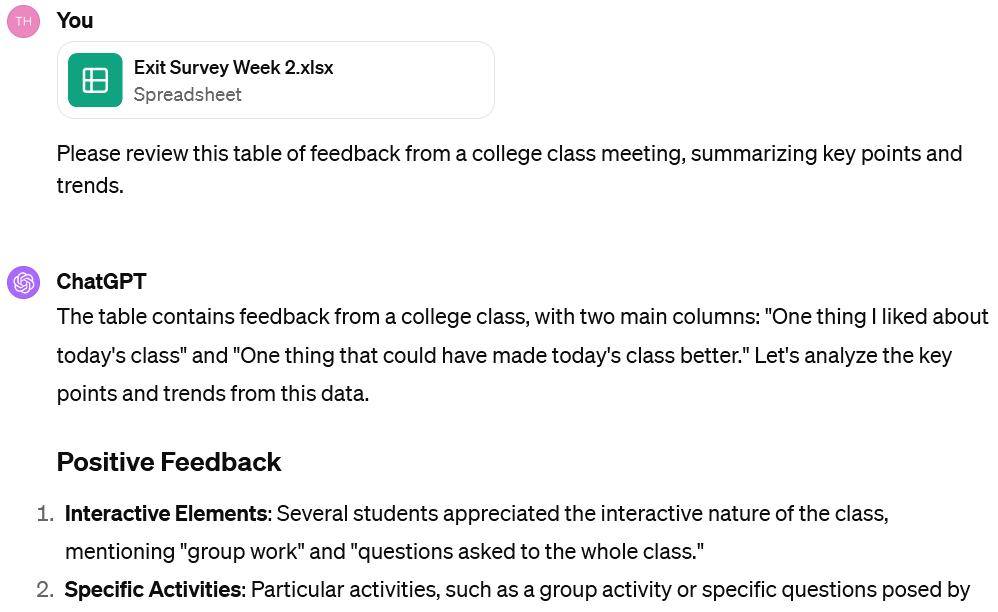12
How can AI tools help instructional staff to complete administrative tasks?
This chapter explores how AI tools can:
- write first drafts of emails, agendas, templates, and other documents;
- help staff manage large amounts of information to summarize, identify trends, or target a search.
Email Writing
In writing, getting started is often the most difficult and time-consuming part. AI tools can produce a first draft of an email from a simple prompt. AI-produced emails tend to need a fair amount of revision to be appropriate to the task, but several RRC Polytech staff have reported that they save time overall and end up including important points that they otherwise may have overlooked.[1] One RRC Polytech leadership staff commented that AI tools are useful for turning a set of notes into a draft of a follow-up email after a meeting with a student, and that AI tools are useful for reviewing a quickly written email to check for tone and professionalism.[2] AI tools can also accept a lesson plan as input and craft an email to a student who missed the class, informing them about key points in the lesson and steps to take to catch up, and can draft a welcome email based on a course description or outline. For more information on training an AI tool to draft emails in your voice, see the Prompting AI Tools to Imitate Your Voice section in the Writing and Refining Prompts chapter.
Document Production and Management
AI tools are effective in producing and managing a variety of documents, including agendas, templates, and data sets. Instructors can take a prepared lesson plan and have an AI tool produce a concise agenda to be posted to the course LMS in advance of the lesson. Some instructors write lesson plans that are for personal use and would be tough for a substitute instructor to follow. AI tools have the potential to prepare a detailed plan for a substitute to follow, based on a rudimentary lesson plan, agenda, or set of notes. One RRC Polytech staff member reported using AI tools to draft meeting agendas, especially for those in which they need to have “difficult conversations.”[3] AI tools can accept a brief description of a situation or an email exchange as input for producing a meeting agenda.
Information Management
In the middle of a teaching term many instructors are too busy with planning, teaching, grading, and student contact to devote adequate time to continuous learning. When interesting but lengthy resources come across an instructor’s desk during a busy working period, AI tools can be employed in reviewing them and producing a summary of key points, or isolating information that is relevant to an instructor’s context. YouTube video transcripts can also be summarized or searched by AI tools, and an extension for Chrome makes this especially easy.[4] AI tools are also able to analyze the transcript of a meeting in order to make recommendations for next steps[5] or to produce draft meeting minutes.
AI tools can also be employed to review a collection of student feedback (for example, an exit survey that asks about the ‘muddiest point’ from the class) in order to make recommendations of what to review in the next class.[6] A practical method for completing a task like this would be to have students complete the survey in Microsoft Forms or another tool that allows the results to be downloaded as an .xlsx file. The instructor could then review the results and delete any personal information such as names and usernames, then share the file with an AI tool, asking it to make recommendations on what to review in the next class.
The following screenshot shows the beginning of ChatGPT’s summary of a class exit survey. Click the link to review the full conversation (login required).

Key Takeaways
- AI tools can write first drafts of emails, templates, meeting agendas, and meeting minutes.
- AI tools can review large amounts of information in order to summarize or make recommendations.
Exercises
- Ask an AI tool to write an email, reprompting and refining until it is usable. Consider whether AI tools can improve your emails and make their production more efficient.
- Experiment with taking an anonymized set of student feedback and asking an AI tool to produce a concise report that highlights key takeaways.
- L. Brunette, focus group, November 25, 2023; Anonymous focus group participants, November 2023. ↵
- Anonymous focus group participant, November 2023. ↵
- Anonymous focus group participant, November 2023. ↵
- Bonnie Stachowiak, "Designing Courses in an Age of AI, with Maria Andersen," last modified January 31, 2024, in Teaching in Higher Ed, podcast, 44:40, https://teachinginhighered.com/podcast/designing-courses-in-an-age-of-ai/. ↵
- John Spencer, "Sal Khan on A.I. and Personalized Learning," John Spencer, last modified August 8, 2023, https://spencerauthor.com/sal-khan/. ↵
- Ethan Mollick, "Using AI to Make Teaching Easier & More Impactful," One Useful Thing, last modified March 17, 2023, https://www.oneusefulthing.org/p/using-ai-to-make-teaching-easier. ↵

